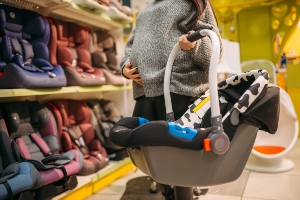Child Passenger Safety

Car accidents remain one of the leading causes of death for children ages 1 to 13. Yet many of these tragedies are preventable simply by the proper use of car seats, booster seats, and seat belts. Use these best practices and safety tips to help protect young lives while on the road.
Child Passenger Safety Tips
- Select a car seat based on your child’s age, weight, and height.
- Always follow your specific car seat manufacturer’s instructions. Be sure to consult your vehicle owner’s manual on how to install the car seat correctly.
- To maximize safety, keep your child in the car seat for as long as they meet the height and weight limits (and as long as the child fits within the manufacturer’s height and weight requirements). No need to rush transitions.
- Children should ride in the back seat at least through age 13.
- Never allow a child to put the shoulder belt of an adult seat belt under an arm or behind the back because it could cause severe injuries in a crash.
Best Practices for Safely Transporting Children
- Rear-facing car seats offer the best protection for infants and toddlers. Keep children rear-facing until they reach the maximum height or weight allowed by the seat’s manufacturer.
- Once outgrown, transition to a forward-facing car seat with a harness. Always use the tether strap when available.
- After outgrowing the forward-facing seat, children should use a belt-positioning booster seat until the vehicle’s seat belt fits properly.
- Even when using a seat belt, children under 13 should remain in the back seat for optimal safety.
Find a Certified Car Seat Inspection Station
Ensure your car seat is installed correctly by visiting a certified inspection station. Use the interactive map to locate a nearby facility in Missouri.
Child Passenger Safety Check Locations | Missouri Department of Transportation
 NHTSA Car Seat Recommendations
NHTSA Car Seat Recommendations
Visit the NHTSA Child Passenger Safety page for full details.
- Birth to 12 months: Rear-facing car seat only.
- 1 to 3 Years: Rear-facing until reach the maximum height/weight allowed, then forward-facing seat with a harness.
- 4 to 7 Years: Forward-facing with harness until outgrown, then booster seat.
- 8 to 12 Years: Booster seat until seat belt fits properly, always in back seat
When is a child ready for an adult seat belt?
Generally, somewhere between the ages of 8 to 12, children will transition from a booster seat to using an adult seat belt. The best practice is to keep them in booster seats until they outgrow the size limits or are big enough to fit properly in seat belts.
Stay Informed: Sign Up for Our Newsletter
If you would like to receive news and updates on a regular basis, sign up to receive our email newsletter. Your email address will only be used to send you our newsletter and respond to inquiries.
Want to stay updated on child safety tips, car seat recalls, and more? Subscribe to our email newsletter. We’ll only use your email to send updates and respond to inquiries.
Sign up for our email
Past results afford no guarantee of future results, and each case is different and is judged on its own merits. The choice of a lawyer is an important decision and should not be based solely upon advertisements.
Photo Credits:
Related

 NHTSA Car Seat Recommendations
NHTSA Car Seat Recommendations